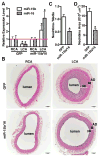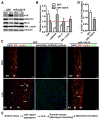MicroRNA-15b/16 Attenuates Vascular Neointima Formation by Promoting the Contractile Phenotype of Vascular Smooth Muscle Through Targeting YAP
- PMID: 26293467
- PMCID: PMC4701035
- DOI: 10.1161/ATVBAHA.115.305748
MicroRNA-15b/16 Attenuates Vascular Neointima Formation by Promoting the Contractile Phenotype of Vascular Smooth Muscle Through Targeting YAP
Abstract
Objective: To investigate the functional role of the microRNA (miR)-15b/16 in vascular smooth muscle (SM) phenotypic modulation.
Approach and results: We found that miR-15b/16 is one of the most abundant mRs expressed in contractile vascular smooth muscle cells (VSMCs). However, when contractile VSMCs get converted to a synthetic phenotype, miR-15b/16 expression is significantly reduced. Knocking down endogenous miR-15b/16 in VSMCs attenuates SM-specific gene expression but promotes VSMC proliferation and migration. Conversely, overexpression of miR-15b/16 promotes SM contractile gene expression while attenuating VSMC migration and proliferation. Consistent with this, overexpression of miR-15b/16 in a rat carotid balloon injury model markedly attenuates injury-induced SM dedifferentiation and neointima formation. Mechanistically, we identified the potent oncoprotein yes-associated protein (YAP) as a downstream target of miR-15b/16 in VSMCs. Reporter assays validated that miR-15b/16 targets YAP's 3' untranslated region. Moreover, overexpression of miR-15b/16 significantly represses YAP expression, whereas conversely, depletion of endogenous miR-15b/16 results in upregulation of YAP expression.
Conclusions: These results indicate that miR-15b/16 plays a critical role in SM phenotypic modulation at least partly through targeting YAP. Restoring expression of miR-15b/16 would be a potential therapeutic approach for treatment of proliferative vascular diseases.
Keywords: YAP; microRNA; neointima formation; phenotypic modulation; smooth muscle.
© 2015 American Heart Association, Inc.
Figures





References
-
- Owens GK, Kumar MS, Wamhoff BR. Molecular regulation of vascular smooth muscle cell differentiation in development and disease. Physiological reviews. 2004;84:767–801. - PubMed
Publication types
MeSH terms
Substances
Grants and funding
LinkOut - more resources
Full Text Sources

